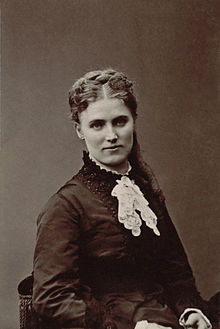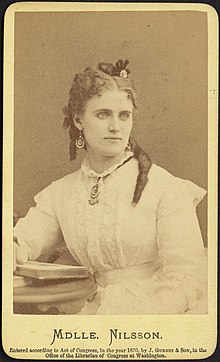Christina Nilsson
| Christina Nilsson | |
|---|---|
 Autographed photograph. | |

Christina Nilsson, Countess de Casa Miranda, also called Christine Nilsson[1] (20 August 1843 – 20 November 1921)[2] was a Swedish operatic soprano. She possessed a bel canto technique and was considered[by whom?] a rival to the Victorian era's most famous diva, Adelina Patti.[citation needed] Nilsson became a member of the Royal Swedish Academy of Music in 1869.
Biography[]
Christina Nilsson was born Kristina Jonasdotter on farm, near Växjö, Småland, to the peasants Jonas Nilsson and Cajsa-Stina Månsdotter. From her earliest years, she demonstrated vocal talent.[3] She taught herself to play on the violin and flute, and sang in the peasants' fairs in Sweden with her brother. She was discovered by a prominent civil servant when, aged 14, she was performing at a market in Ljungby. He soon became her patron, enabling her to take vocal training. She was a pupil of Franz Berwald for two years.[citation needed]

In 1860, she gave concerts in Stockholm and Uppsala. After four years' study in Paris, she had her operatic début 1864 in the title role of Verdi's opera La Traviata at the Théâtre Lyrique, Paris.[3] After this success she sang at major opera houses in London, New York City, Moscow, Saint Petersburg, Brussels and Munich.[2] In New York City, she appeared in the Metropolitan Opera's inaugural performance on 22 October 1883 in Gounod's Faust.[citation needed]
In September 1885 she was contemplating retiring from the spotlight, and held a farewell concert from the balcony of Grand Hotel in Stockholm. An estimated 50,000 people gathered to hear the world-famous soprano. Suddenly a rumour spread that the scaffolding on a nearby building was falling down, and panic spread in the crowd. 19 people were killed in the chaos that followed, and the dead bodies and all the injured were brought to the hotel lobby, where a horrified Nilsson met them. The Stockholm police were criticized for the way they handled the event, and Nilsson never got over the accident. She donated generously to the families of the victims.[citation needed]
In 1872 Christina Nilsson married the French banker Auguste Rouzaud in Westminster Abbey, who later died in 1882. In 1887 she married Angel Ramon Maria Vallejo y Miranda es, Count de Casa Miranda es, who died in 1902.[3] In correspondence, Nilsson often signed her first name as Christine, and during the last part of her life she was generally known as the Countess de Casa Miranda.[citation needed]
She died in Växjö, Sweden, in 1921. Unlike Patti, she never made gramophone recordings of her voice.[citation needed]

In literature[]
She is a minor character in The Age of Innocence by Edith Wharton.[4]
She is mentioned in Anna Karenina by Leo Tolstoy.[5]
Notes[]
- ^ "Nilsson, Christine (1843–1921) | Encyclopedia.com". www.encyclopedia.com.
- ^ Jump up to: a b Warrack, John; West, Ewan (1996). The Concise Oxford Dictionary of Opera. Oxford University Press. p. 365. ISBN 978-0-19-280028-2. Retrieved 20 August 2021.
- ^ Jump up to: a b c Emens, Helen Byington (1896). "Women as Vocalists". In King, William C. (ed.). The World's Progress as Wrought by Men and Women in Art, Literature, Education, Philanthropy, Reform, Inventions, Business and Professional Life. Springfield, Massachusetts: King-Riehardson Publishing Co. pp. 476–478. Retrieved 4 May 2015.
- ^ "The Project Gutenberg E-text of The Age of Innocence, by Edith Wharton". www.gutenberg.org.
- ^ "Anna Karenina, by Leo Tolstoy". gutenberg.org.
References[]
- Gustaf Hilleström: Kungl. Musikaliska Akademien, Matrikel 1771–1971 (The Royal Academy of Music 1771–1971) (in Swedish)
- The Compelling: A Performance-Oriented Study of the Singer Christina Nilsson, Ingegerd Björklund, Göteborg, 2001
- Die Goede Oude Tyd, by Anton Pieck and Leonhard Huizinga, Zuid-Hollandsche Uitgeversmaatschappy, Amsterdam, 1980, page 31.
- De Werelde van Anton Pieck, text by Hans Vogelesang, La Riviere & Voorhoeve, Kampen, 1987, page 197.
- Wilson, J. G.; Fiske, J., eds. (1900). . Appletons' Cyclopædia of American Biography. New York: D. Appleton.
Further reading[]
- Björklund, Ingegerd Christina Nilsson at Svenskt kvinnobiografiskt lexikon
- Guy de Charnacé: A star of song! the life of Christina Nilsson
External links[]
 Media related to Christina Nilsson at Wikimedia Commons
Media related to Christina Nilsson at Wikimedia Commons
- 1843 births
- 1921 deaths
- Royal Philharmonic Society Gold Medallists
- Swedish sopranos
- Swedish operatic sopranos
- People from Växjö
- 19th-century Swedish opera singers
- 19th-century women opera singers
- 19th-century Swedish women